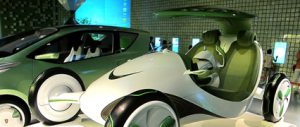China’s electric car market remains stalled. Only 4,400 vehicles were bought between the introduction of government promotional policies in 2009 and the end of 2012, most of them in Shenzhen and Hefei, according to electric vehicle website d1ev.com.
Inconsistent subsidies are one factor hampering sales. To encourage uptake of electric vehicles over their more expensive fuel-burning competitors, subsidies are being provided from central and in some circumstances, local governments. If you buy the 360,000 yuan (US$59,000) BYD E6 vehicle in Shenzhen, you get a 60,000 yuan (US$9,500) subsidy from the central government, and matching funds from the local government – meaning you drive your new electric car home for about 240,000 yuan (US$39,500).
But local governments only subsidise local firms: BYD is based in Shenzhen. Buy the same car in Beijing, and you lose out on the Shenzhen subsidy. Understandably, this is putting many people off.
Subsidies are distorting the sector as a whole. At the Global Automotive Forum in Wuhan, Dongfeng Motor president Zhu Fushou said that “many firms have put a lot of work into alternative fuel vehicles, but see no hope for commercialisation. The only aim now is to get government funding and subsidies – nobody thinks about what the market wants.”
A further problem is that the BYD E6 car needs to be added to a Beijing municipal government list of approved vehicles. Without this it is ineligible for Beijing license plates, subsidies, and no recharging points will be built.
Wang Zhuangfu, the CEO of BYD claims that local protectionism is blocking the popularisation of the electric car. One official with the Beijing Science and Technology Committee, who preferred to remain anonymous, said that many local governments require car-makers to have local factories or a certain number of dealerships before granting such privileges.
Nowhere to recharge
Recharging networks are very costly to build. Funding initially came from the State Grid and the China Southern Power Grid. But the State Grid has gone off the project, leaving a question mark hanging over investment. Local governments continue to produce optimistic development plans, including construction of recharging facilities, but it is uncertain if and how these will be implemented.
Beijing plans to have 195,000 alternative fuel vehicles on the road by 2017, and has a year-by-year breakdown of how to achieve this. But one source close to the city’s science and technology committee said the government is already “tearing its hair out.”
Wang Jie, head of BYD’s Green Public Transport Department, said that “recharging networks don’t benefit from economy of scale unless electric cars are popular. But if recharging stations aren’t common, you can’t popularise electric cars.”
The issue is further complicated by local governments and companies building different types of recharging points, meaning that an electric car purchased in Shenzhen may not be able to use a recharging station in Hangzhou or Beijing. Fu Yi, deputy president of Potevio, says that unified planning and standards for such infrastructure is necessary if alternative vehicles are to become commercially viable.
A contractor working on recharging networks in Tianjin said that initially recharging points were just built where politicians wanted them – there was no real planning.
Keeping up on technology
There is a huge gap between most Chinese electric vehicle makers and their overseas competitors. Foreign and joint-venture manufacturers have invested much more in their products than Chinese firms, with many local companies planning to wait for the market to take off and then copy the technology.
Battery technology – which is central to the electric car – needs to be more standardised and safer. Although China is starting to research components used in electric control systems, large-scale production is still some way off.
BYD started as a battery-maker, and has an R&D advantage over its domestic competitors. But it is still a young company with limited financial resources: it cannot commercialise products like the multinationals.
It’s been estimated that total investment in electric cars for 13 Chinese firms, including Chang’an, Baic, BYD and JAC will add up to 17 billion yuan (US$2.8 billion) by 2015. That is only three times as much as the 5.1 billion yuan (US$800 million) General Motors spent on a single vehicle, its Chevrolet Volt, and less than a third of Toyota’s annual R&D spending on alternative fuel vehicles.
“Our technology is nowhere near as good as theirs, so there’s not much chance of overtaking them,” says Li Xiangqiang, president and CEO of Shenzhen battery-maker BAK. He thinks the most pressing issue for China’s companies is to boost technology R&D and produce reliable products consumers will feel confident in. “If that happens, electric cars will take off.”
This is an edited version of an article that appeared in Caixin New Century Weekly







